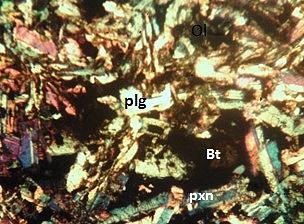Natural resources in the environment (A case study of basaltic rocks in Ameta, southern Benue Trough, Nigeria)
Keywords:
Ameta, Basaltic rocks, Gabbro, Rare earth elementsAbstract
Rare earth element (REE) Geochemistry of the basaltic rocks in Ameta were studied in order to determine the fractionation pattern of the magma that form the rocks and as well to determine the economic potential of the REE in the rocks. The field occurrence of the basaltic rock shows evidence of decrease in the thermal effects of the magma. Presence of phenocrysts of mafic minerals (biotite and olivine) in the rocks indicate slow rate of cooling of the magma that gave rise to the rocks. Field occurrence depicts that crystallization of the magma closed the vent through which the magma erupted thereby making the rocks to appear as plutons. The rare earth element geochemistry of the rocks shows the fractionating pattern of the magma. The REE is characterized by a sloping pattern which indicates the trend of the fractionation. There are enrichment of most of the light rare earth elements (LREE) and depletion of the heavy rare earth element (HREE). There are slight positive Eu anomalies in the rocks which defines the level of plagioclase fractionation. The concentration of REE in the rocks have shown the economic potentials of the rocks. REE is a useful natural resource for 21st century technology.
References
Castor, S.B., Hedrick, J.B., 2006. Rare earth elements. In British Geological Survey, Natural Environment Research Council, 1-5.
Fairhead, J.D., Okereke, C.S., 1987. A regional gravity study of the West African rift system in Nigeria and Cameroon and its tectonic implication. Tectonophysics, 143, 141-159.
Jarvis, I., Jarvis, K.E., 1992a. Inductively coupled plasma atomic emission spectrometry in exploration geochemistry. J. Geochem. Explor., 44, 139-200.
Jarvis, I., Jarvis, K.E., 1992b. Plasma spectrometry in the earth sciences: Techniques, applications and trends. Chem. Geol., 95, 1-33.
Kogbe, C.A., 1976. The Cretaceous and Palaeogene sediments of southern Nigeria. In Geology of Nigeria, C.A. Kogbe (ed.). Lagos: Elizabeth publishing Co.
Langmuir, C.H., Bender, J.P., Bence, A.C., Hanson, G.N., Taylor, S.R., 1977. Petrogenesis of basalts from the famous Mid-Atlantic Ridge. Earth. Planet. Sci. Lett., 36, 133.
Long, K.R., Van Gosen, B.S., Foley, N.K., Cordier, D., 2010. The principal rare earth elements deposits of the United States. A summary of domestic deposits and a global perspective: US Geological Survey Scientific Investigations Report. In British Geological Survey, Natural Environment Research Council, 1-5.
Nwachukwu, S.O., 1972. The tectonic evolution of the southern portion of the Benue Trough, Nigeria. Geol. Mag., 109(5), 411-419.
Odigi, M.I., Amajor, L.C., 2009. Brittle deformation in the Afikpo Basin, Southern Nigeria: Evidence for a Terminal Cretaceous extensional regime in the Lower Benue Trough, Nigeria. China. J. Geochem., 28, 369-376.
Ofoegbu, C.O., 1985. A review of the geology of the Benue Trough of Nigeria. J. Afr. Earth. Sci., 3, 283-291.
Onwualu-John, J.N., Ukaegbu, V.U., 2009a. Petrogenetic and geotectonic implication of Lokpa Ukwu pyroclastics in Southern Benue Trough. Nigeria. Pac. J. Sci. Technol., 10(1), 487-498.
Onwualu-John, J.N., Ukaegbu, V.U., 2009b. Geochemistry of the association of syenodiorites and pyroclastics in the Southern Benue Trough, Nigeria: Petrogenetic and Tectonic implications. World. J. Appl. Sci. Technol., 1(1), 11-27.
Thompson, M., Walsh, J.N., 1983. A handbook of Inductively Coupled Plasma spectrometry. Blackie. Glasgow. 83-127.

Downloads
Published
How to Cite
Issue
Section
License
Copyright (c) 2020 I.I. Dilioha, Josephine Nchekwube Onwualu-John

This work is licensed under a Creative Commons Attribution-NonCommercial-NoDerivatives 4.0 International License.



